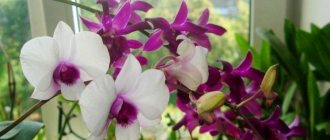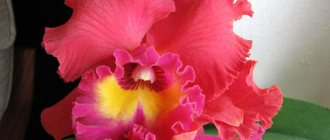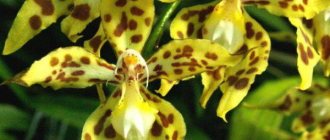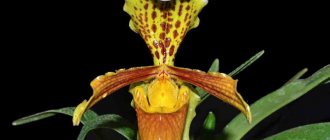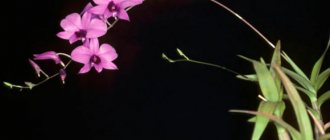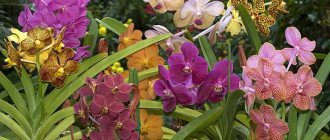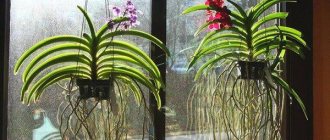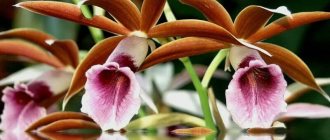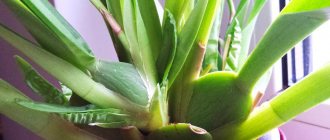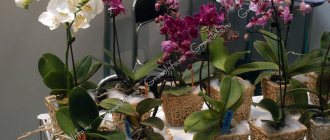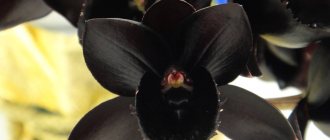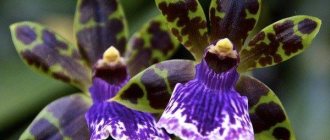In the large family of Phalaenopsis, you can sometimes notice plants with an unusual bud shape. As a result of the mutation, the flower grows together, and outwardly it looks like an unopened bud. The two horizontal petals transform into a lip, and the flower becomes asymmetrical. This phenomenon is not considered permanent; pelorica orchids may produce regular flowers in the future. This article talks about the varieties of phalaenopsis pelorica, their distinctive features, as well as the rules for planting, propagating and caring for flowers.
Distinctive features
There are unstable forms of mutation; one plant can produce a peloric and a regular flower. The appearance of peloricity is associated with genes, but sometimes on an ordinary flower it occurs as a result of poor care or stress. In such plants, peloricity is unstable; when comfortable conditions are restored, the mutation may disappear and the plant will bloom as usual.
What is the difference between the peloric orchid and other flowers in this family? In addition to the unopened bud, sometimes various petals or sepals grow, resembling a lip in shape and color. You can look at the photo of the peloric orchid and appreciate the unusual appearance of the flower.
This plant has a peculiar appearance. In addition, sometimes the petals become thicker. All biologists are unanimous in the opinion that this is a mutation of the plant, and amateur flower growers sometimes strive to purchase peloric flowers. Further in the article - about the most famous varieties of the Phalaenopsis peloric orchid.
In nature and home floriculture - colors and types
It is important to always remember that if peloricity in nature itself does not appear very often, then when hybridization occurs, the phenomenon will begin to repeat itself. Pelorics with loose peloricity are generally called butterflies. In this case, completely normal pelorics and flowers bloom simultaneously on just one peduncle. These are semipelorics.
There is also a wonderful variety called kaleidoscope. It is distinguished by a very interesting color of flowers. As a rule, it has various shades and colors. But the burgundy variety is considered the most beautiful and quite rare species. Depending on the hybrid itself, it may have different patterns and even shades. Phalaenopsis peloric can also be a solid burgundy color or decorated with a mesh pattern.
Note also the yellow peloric. The height of such a plant reaches generally 70 centimeters, and along its entire length it is strewn with beautiful flowers. It can manifest itself not only as a peloric, but also as a semipeloric.
Be sure to pay attention to the pink phalaenopsis with various petals that more closely resemble lips. As a rule, this species has stable peloricity. In a fairly large number of cases, it grows with several peduncles; they can be 60 centimeters in height.
How to distinguish peloric from a normal orchid?
In some cases, you may find various petals, flowers, and sepals that have the color and shape of a lip, or, conversely, the lip is similar to the petals. This plant has a rather unusual appearance, and at the same time it causes an incredible amount of controversy among all flower growers, not only among professionals, but also among amateurs. Some people think that this is just a defect, while others strive to purchase exclusively pelorics at any cost.
If an unstable form of mutation occurs, this plant can bloom with very ordinary flowers and at the same time peloric. Such errors in morphology can be different and they always manifest themselves in different ways. In addition to a rather interesting shape, there may also be a compaction and even an increase in the structure of the petals themselves. All these processes are considered inevitable.
If we talk about peloricity, then, as a rule, it manifests itself very unstable. And any plant that blooms with pelorics can, in principle, bloom another time with flowers common to this species.
Preparing the soil for planting
Like all orchids, pelorics need well-chosen soil. It is the basis for the proper development of a flower. A substrate is prepared for the plant from pine bark (you can take it from other coniferous trees), sphagnum moss and a small amount of inert materials: vermiculite, expanded clay, perlite. These materials serve as drainage and promote better aeration of the roots.
When using expanded clay for planting, it is necessary to take into account that the roots of the orchid easily grow into it, this leads to some difficulties in further transplanting the flower. In this case, the roots must be carefully separated from the expanded clay.
The basis of the substrate is bark. Before planting, it must be dry and free of pests. You can pre-steam it in the oven. The bark absorbs all salts from the water well and acts as a filter.
If there is no desire or opportunity to prepare the substrate yourself, it can be purchased at flower shops. The quality of the finished material does not cause any complaints among experienced gardeners involved in breeding orchids.
Selection of container and planting
All orchids absorb light through their roots, so you need to choose transparent pots for them. Their sizes must be selected according to the volume of the root system.
Planting orchids is usually not difficult. A drainage layer is laid on the bottom of the pot, then the plant with a lump of earth is carefully placed and covered with substrate. The root collar should not reach three centimeters to the edge of the pot.
The planted plant is removed for two weeks in a moderately cool room for adaptation. Then the orchid is determined to a permanent place.
Watering and fertilizing
It is when growing the phalaenopsis pelorica orchid that watering is of great importance. Most varieties of this plant love moisture, but here you should not be too zealous and flood the flower. You need to focus on the drying of the soil and the color of the roots.
With normal humidity in the apartment, the soil usually dries out on the 3-4th day. The roots take on a silver-gray tint. This means that the flower already needs watering. The dry climate in the apartment negatively affects the leaves of the peloric orchid. In this case, it is necessary to spray the leaves of the flower, but make sure that water does not get on the buds.
It is recommended to fertilize once a month; in winter it is reduced to once. They use special complex fertilizers, which can be purchased at flower shops.
Care
Phalaenopsis watered with warm water
For good adaptation of the plant after planting, it is necessary to properly care for it: water, feed, prune, stimulate the flowering process.
Watering
Phalaenopsis is watered with moderately warm, settled or filtered water, the temperature of which is 2-3°C above room temperature.
It is advisable to water in the first half of the day, 1-2 times a week. In dry climates it should be more regular.
Methods:
- immersion in water for 15-30 minutes;
- pour under a running shower for 15-20 minutes;
- watering from above.
Water the flowers abundantly, but at the same time carefully ensure that the substrate has time to dry completely beforehand and the roots have a silvery tint. Overmoistening can lead to rotting, and lack of moisture can lead to inhibition of shoot and root growth, leaf lethargy, and thinning of roots.
Recommendation: if after 1 hour there is still water in the axils of the leaves, blot it with a dry cloth.
Feeding
Orchids cannot be fertilized:
- within 2 months after purchase;
- during flowering, as this can speed up the flowering of phalaenopsis;
- within a month after transplantation, when the flower is stressed.
Orchids are fertilized in a state of active growth, when roots and leaves grow, and new buds form.
It is not recommended to feed phalaenopsis with organic fertilizers, as there is a high risk of burns to the roots and leaves.
It is better to use special complexes “for orchids”: Agricola, Bona Forte, Kemira-Lux, Uniflor-bud, Uniflor-rost, Greenworld, Pocon, etc. Plants react very well to succinic acid.
Fertilizer application frequency:
- in summer - 2 times a month;
- in winter - once a month.
Important! Before fertilizing the flowers, be sure to water them well so that the roots are moist. If fertilizer gets on dry roots, it can cause them to burn.
Replanting a plant after purchasing it in a store
An orchid purchased in a store must be transplanted from a temporary container into a permanent pot. In this case, the entire temporary substrate is completely replaced, leaving only an earthen lump on the roots. An actively flowering plant does not need to be replanted immediately, as this will cause the buds to fall off.
A plant without flowers is transplanted into a permanent pot. Phalaenopsis peloric orchid tolerates transplantation well. The main thing is to choose a high-quality substrate for it. The flower is carefully removed from the temporary pot and the roots are carefully examined. If there are rotten areas, they must be removed. The cut areas are treated with crushed activated carbon.
Then carefully lower the orchid’s root system into a new pot, carefully straightening the roots so that they do not bend. Pour wet substrate into the pot and place the plant for acclimatization. Watering is stopped for two weeks, and the flower pot is placed in a cool, shaded place.
Diseases and pests
With proper care, the plant rarely gets sick
Most often, damage to various diseases and fungi occurs due to errors in the watering procedure and unsuitable temperature for the plant.
Brown spot. Signs: yellow or dark spots, streaks, stripes on the leaves, sticky coating, leaf lethargy. The affected leaves are removed, and the cut site is treated with iodine.
Powdery mildew. White coating on leaves and buds. The flower is watered, after 2-3 hours it is sprayed with the fungicidal preparation Skor and colloidal sulfur. Phytophthorin is used for prevention.
Rot (symptoms - fuzzy coating, spots and spots). Kinds:
- Gray. Treatment: treatment with Immunocytophyte. Prevention: use of bioimmunostimulants.
- Brown. Treatment: treatment with colloidal sulfur, fungicides. Prevention: spraying the plant with a solution of copper sulfate.
- Black. Treatment: diseased parts are cut off, the cut site is impregnated with colloidal sulfur.
- Fusarion (grayish tint of leaves, pink bloom, flabbiness). Treatment: three times a day for 2 weeks, the container with the plant is completely immersed in a 3% Fundazol solution.
Anthracnose. Signs: leaves being eaten away, small growing black spots. Damaged areas are removed to healthy tissue. The wound is sprinkled with ash and lubricated with iodine. Severe lesions are treated with fungicides Skor, Ridomil in 3-4 approaches with breaks of 10 days. Prevention: treatment with Mikosan.
Rust. First, the lower part of the leaves becomes covered with light spots. Gradually, the entire leaf twitches with a rusty coating. Treatment: removal of affected leaves, treatment of cut areas with activated carbon. For small lesions, spray with a 20% alcohol solution; for significant lesions, use fungicides.
The most common pests on plants are:
- spider mite;
- scale insect;
- mealybug;
- aphid;
- thrips.
To get rid of pests, the pot with the plant is immersed in water for 15 minutes, the affected areas are wiped with a water-soap solution, and treated with insecticides and acaricidal preparations.
It is necessary to remove dried flower stalks, leaves, and damaged roots in a timely manner.
Stimulating flowering
Typically, Phalaenopsis peloric hybrids bloom twice a year. Some gardeners are faced with the problem that the plant does not bloom, despite all their efforts. This is mainly due to the fact that it does not have enough light.
If the orchid does not bloom, this problem can be solved in two ways. Some gardeners provide the plant with additional artificial lighting.
Another way is to put the flower in a cool room where the temperature does not exceed 16 °C, and also reduce watering. The flower is kept in such conditions for 20 to 30 days, and then returned to normal conditions. After this, the orchid forms arrows and blooms. After the plant has finished flowering, the peduncle is cut off, but if it does not dry out, it can be left on the plant, since it will produce buds again in the future.
Some varieties and varieties
Today there are about 70 natural varieties of orchids, with more than 100 varieties additionally bred by breeders. Among the most popular crops are the following varieties.
Black butterfly
The black butterfly has an attractive appearance. As practice shows, color may change depending on lighting. Shades can vary from rich burgundy with a chocolate tint to black.
Diamond King
A distinctive feature of this variety is the rather rich and bright burgundy shade of the buds, while the petals have a light-colored border. The buds reach a diameter of 8 cm.
Manhattan
To date, this hybrid has not undergone the registration process, so it only has a trade name. The buds are light pink, with a large number of small inclusions of burgundy. The core is yellow and orange.
Pavarotti
Phalaenopsis of this variety is known to many gardeners due to its dense, almost monochromatic flowers that have a fairly rich and attractive wine tint. The diameter of the buds can reach 8 cm.
Valencia
It is a very rare variety of orchid, the maximum height is 60 cm including peduncles. The sepals and petals are snow-white, the lip is very large, the inner part is yellow, and the outer part is white.
Kimono
If you look at the photo, you can see that the buds are a rich purple color, the border of the petals is whitish-yellow. At the same time, the veins and tongue are very dark, the central part is crimson. Bud diameter – 7 cm.
Legato
It is a hybrid that differs from other varieties in its unusual shade. The height of the peduncle is about 60 cm. Flowering occurs several times a year and lasts 7-8 weeks.
Peloric
Pelorik does not belong to any of the existing varieties of orchids. This is the name given to crops whose buds have an unusual shape. Such changes occur as a result of mutations.
Prevention of diseases and pests
Infectious diseases rarely affect Phalaenopsis pelorica. They usually suffer from improper care. Direct sunlight can cause leaf scorch if the plant is placed on a windowsill on the south side of the house.
Orchids often suffer from excessive watering, the roots of the plant rot, and the green part dries out. Lack of lighting and keeping them in a cold room can also cause disease and death of the plant. A dense arrangement of orchids is not recommended; free air circulation is necessary for each plant. Periodically you need to ventilate the room, avoid allowing moisture to get on the buds when spraying. Irrigation of leaves is carried out in the first half of the day.
Sometimes pests are found on a plant sold in a store. In this case, the root system is completely separated from the soil in which the flower was sold. The plant is placed under water at room temperature and the roots are thoroughly washed.
Pelorics require high humidity in the room, but this can be easily achieved by placing a tray filled with damp pebbles or expanded clay next to the orchid. Creating comfortable conditions for keeping an orchid will protect the plant from various diseases.
